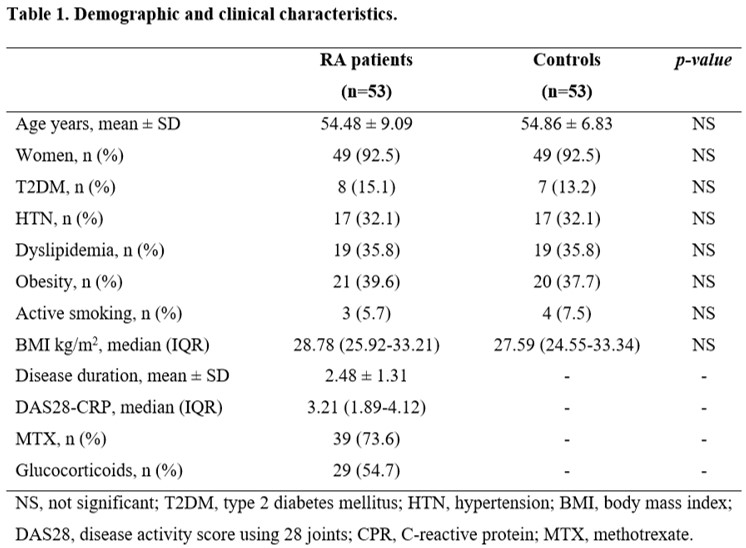Session Information
Date: Saturday, November 6, 2021
Title: RA – Diagnosis, Manifestations, & Outcomes Poster I: Cardiovascular Pulmonary Disease (0268–0295)
Session Type: Poster Session A
Session Time: 8:30AM-10:30AM
Background/Purpose: Patients with rheumatoid arthritis (RA) have a higher risk of developing a cardiovascular (CV) event than the general population, due to an accelerated process of atherosclerosis, which has been documented to begin in early stages of the disease and is directly associated with systemic inflammation.
The aim of this study was to compare the prevalence of subclinical atherosclerosis detected by carotid ultrasound (US) in patients with RA in the first five years of diagnosis and healthy controls.
Methods: This was a cross-sectional, observational, and comparative study. A total of 53 patients aged 40-75 years old, with RA diagnosis, in the previous five years, according to the 2010 ACR/EULAR classification criteria, and 53 controls matched by age (±5 years), gender and comorbidities were included in this study. Subjects with a previous CV event were excluded. A carotid US was performed in all study subjects. Subclinical atherosclerosis was evaluated as the presence of carotid plaque (CP) or an increased carotid intima media thickness (cIMT). CP was defined as a cIMT ≥1.2mm or a focal narrowing ≥0.5mm of the surrounding lumen, and an increased cIMT was defined as a value ≥0.8mm. Distribution was evaluated with the Kolmogorov-Smirnov test. Comparisons were done with χ2 test and Fisher’s exact test for qualitative variables, and Student’s T test and Mann-Whitney’s U test for quantitative variables. A p-value < 0.05 was considered statistically significant.
Results: Comparisons of demographic characteristics showed no difference between the RA group and the control group (Table 1). When comparing carotid US findings there was a difference in the presence of CP, being more prevalent in RA patients (26.4% vs 11.3%, p=0.047), in the presence of an increased cIMT, being more prevalent in RA patients (32.1% vs 3.8%, p=< 0.001), in the cIMT as a quantitative variable, being higher in RA patients (0.75mm vs 0.60mm, p=0.001), and in the presence of subclinical atherosclerosis overall, being more prevalent in RA patients (52.8% vs 15.1%, p=< 0.001) (Table 2).
Conclusion: Patients with RA in the first five years of diagnosis have a higher prevalence of subclinical atherosclerosis than the general population. CV evaluation including a carotid US should be done at the time of diagnosis of RA patients, and subsequently it must be individualized according to the CV risk of each patient, with a maximum of five years to identify those patients who would benefit from an opportune treatment.
To cite this abstract in AMA style:
Guajardo-Jauregui N, Galarza-Delgado D, Colunga-Pedraza I, Azpiri-Lopez J, Rodriguez-Romero A, Loya-Acosta J, Meza-Garza A, Cardenas-de La Garza J, Lugo-Perez S, Castillo-Treviño J. Higher Prevalence of Subclinical Atherosclerosis in the First Five Years of Rheumatoid Arthritis Diagnosis [abstract]. Arthritis Rheumatol. 2021; 73 (suppl 9). https://acrabstracts.org/abstract/higher-prevalence-of-subclinical-atherosclerosis-in-the-first-five-years-of-rheumatoid-arthritis-diagnosis/. Accessed .« Back to ACR Convergence 2021
ACR Meeting Abstracts - https://acrabstracts.org/abstract/higher-prevalence-of-subclinical-atherosclerosis-in-the-first-five-years-of-rheumatoid-arthritis-diagnosis/


